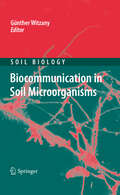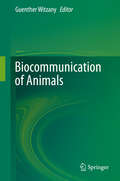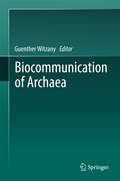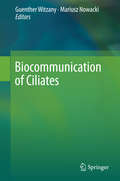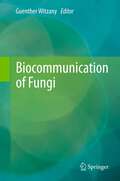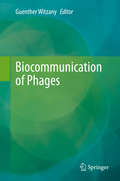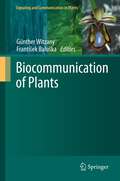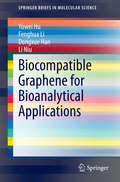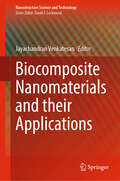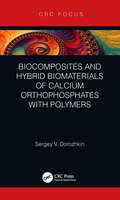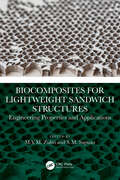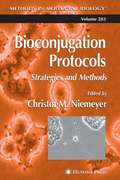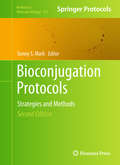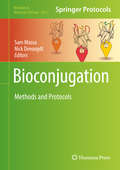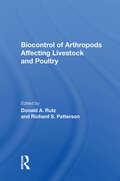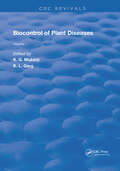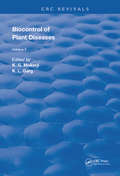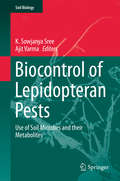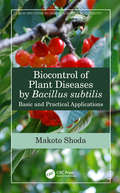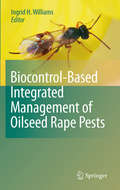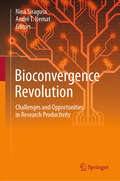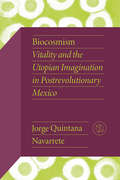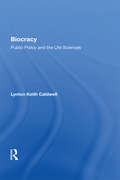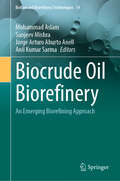- Table View
- List View
Biocommunication in Soil Microorganisms (Soil Biology #23)
by Günther WitzanyCommunication is defined as an interaction between at least two living agents which share a repertoire of signs. These are combined according to syntactic, semantic and context-dependent, pragmatic rules in order to coordinate behavior. This volume deals with the important roles of soil bacteria in parasitic and symbiotic interactions with viruses, plants, animals and fungi. Starting with a general overview of the key levels of communication between bacteria, further reviews examine the various aspects of intracellular as well as intercellular biocommunication between soil microorganisms. This includes the various levels of biocommunication between phages and bacteria, between soil algae and bacteria, and between bacteria, fungi and plants in the rhizosphere, the role of plasmids and transposons, horizontal gene transfer, quorum sensing and quorum quenching, bacterial-host cohabitation, phage-mediated genetic exchange and soil viral ecology.
Biocommunication of Animals
by Guenther WitzanyEvery coordination within or between animals depends on communication processes. Although the signaling molecules, vocal and tactile signs, gestures and its combinations differ throughout all species according their evolutionary origins and variety of adaptation processes, certain levels of biocommunication can be found in all animal species: (a) Abiotic environmental indices such as temperature, light, water, etc. that affect the local ecosphere of an organism and are sensed, interpreted. (b) Trans-specific communication with non-related organisms. (c) Species-specific communication between same or related species. (d) Intraorganismic communication, i. e. , sign-mediated coordination within the body of the organism. This book gives an overview of the manifold levels of animal communication exemplified by a variety of species and thereby broadens the understanding of these organisms.
Biocommunication of Archaea
by Guenther WitzanyArchaea represent a third domain of life with unique properties not found in the other domains. Archaea actively compete for environmental resources. They perceive themselves and can distinguish between 'self' and 'non-self'. They process and evaluate available information and then modify their behaviour accordingly. They assess their surroundings, estimate how much energy they need for particular goals, and then realize the optimum variant. These highly diverse competences show us that this is possible owing to sign(aling)- mediated communication processes within archaeal cells (intra-organismic), between the same, related and different archaeal species (interorganismic), and between archaea and nonarchaeal organisms (transorganismic). This is crucial in coordinating growth and development, shape and dynamics. Such communication must function both on the local level and between widely separated colony parts. This allows archaea to coordinate appropriate response behaviors in a differentiated manner to their current developmental status and physiological influences. This book will orientate further investigations on how archaeal ecosphere inhabitants communicate with each other to coordinate their behavioral patterns and whats the role of viruses in this highly dynamic interactional networks.
Biocommunication of Ciliates
by Guenther Witzany Mariusz NowackiThis is the first coherentdescription of all levels of communication of ciliates. Ciliates are highlysensitive organisms that actively compete for environmental resources. Theyassess their surroundings, estimate how much energy they need for particular goals,and then realise the optimum variant. They take measures to control certainenvironmental resources. They perceive themselves and can distinguish between'self' and 'non-self'. They process and evaluate information and then modifytheir behaviour accordingly. These highly diverse competences show us that this is possible owing to sign(aling)-mediated communication processes within ciliates (intra-organismic), between the same, related and different ciliate species (inter-organismic), and between ciliates and non-ciliate organisms (trans-organismic). This is crucial in coordinating growth and development, shape and dynamics. This book further serves as a learning tool for research aspects in biocommunication in ciliates. It will guide scientists in further investigations on ciliate behavior, how they mediate signaling processes between themselves and the environment.
Biocommunication of Fungi
by Günther WitzanyFungi are sessile, highly sensitive organisms that actively compete for environmental resources both above and below the ground. They assess their surroundings, estimate how much energy they need for particular goals, and then realise the optimum variant. They take measures to control certain environmental resources. They perceive themselves and can distinguish between 'self' and 'non-self'. They process and evaluate information and then modify their behaviour accordingly. These highly diverse competences show us that this is possible owing to sign(aling)-mediated communication processes within fungal cells (intraorganismic), between the same, related and different fungal species (interorganismic), and between fungi and non-fungal organisms (transorganismic). Intraorganismic communication involves sign-mediated interactions within cells (intracellular) and between cells (intercellular). This is crucial in coordinating growth and development, shape and dynamics. Such communication must function both on the local level and between widely separated mycelium parts. This allows fungi to coordinate appropriate response behaviors in a differentiated manner to their current developmental status and physiological influences.
Biocommunication of Phages
by Guenther WitzanyThis is the first book to systemize all levels of communicative behavior of phages. Phages represent the most diverse inhabitants on this planet. Until today they are completely underestimated in their number, skills and competences and still remain the dark matter of biology. Phages have serious effects on global energy and nutrient cycles. Phages actively compete for host. They can distinguish between ‘self’ and ‘non-self’ (complement same, preclude others). They process and evaluate available information and then modify their behaviour accordingly. These diverse competences show us that this capacity to evaluate information is possible owing to communication processes within phages (intra-organismic), between the same, related and different phage species (interorganismic), and between phages and non-phage organisms (transorganismic). This is crucial in coordinating infection strategies (lytic vs. lysogenic) and recombination in phage genomes.In 22 chapters, expert contributors review current research into the varying forms of phage biocommunication and Phagetherapy. Biocommunication of Phages aims to assess the current state of research, to orient further investigations on how phages communicate with each other to coordinate their behavioral patterns, and to inspire further investigation of the role of non-phage viruses (non-lytic, non-prokaryotic) in these highly dynamic interactional networks.
Biocommunication of Plants (Signaling and Communication in Plants #14)
by František Baluška Günther WitzanyPlants are sessile, highly sensitive organisms that actively compete for environmental resources both above and below the ground. They assess their surroundings, estimate how much energy they need for particular goals, and then realise the optimum variant. They take measures to control certain environmental resources. They perceive themselves and can distinguish between 'self' and 'non-self'. They process and evaluate information and then modify their behaviour accordingly. These highly diverse competences are made possible by parallel sign(alling)-mediated communication processes within the plant body (intraorganismic), between the same, related and different species (interorganismic), and between plants and non-plant organisms (transorganismic). Intraorganismic communication involves sign-mediated interactions within cells (intracellular) and between cells (intercellular). This is crucial in coordinating growth and development, shape and dynamics. Such communication must function both on the local level and between widely separated plant parts. This allows plants to coordinate appropriate response behaviours in a differentiated manner, depending on their current developmental status and physiological influences. Lastly, this volume documents how plant ecosphere inhabitants communicate with each other to coordinate their behavioural patterns, as well as the role of viruses in these highly dynamic interactional networks.
Biocompatible Graphene for Bioanalytical Applications (SpringerBriefs in Molecular Science)
by Yuwei Hu Fenghua Li Dongxue Han Li NiuThis book highlights the latest advances in the use of graphene and bio-compatible-material-decorated graphene to detect various targets (e. g. DNA, RNA, amino acids, peptides, proteins, enzymes, antigens, glucose, DA, AA, UA, ATP, NADH, gas, ions, etc. ). It focuses on the specific interaction of these substances with graphene (or modified graphene) and the efficient transduction of the target recognition event into detectable signals via various techniques. Particular emphasis is given to well-designed strategies for constructing graphene-based platforms and target determination. It also covers other bio-analytical applications including cellular imaging, drug delivery and bacteria inhibition, before turning to a discussion of future challenges and prospects of graphene in bio-analytical applications. This book is intended for researchers working in the fields of analytical chemistry, nanomaterials and biomedical engineering. Li Niu is a Professor at the State Key Laboratory of Electroanalytical Chemistry, Changchun Institute of Applied Chemistry, Chinese Academy of Sciences.
Biocomplexity of Plant-Fungal Interactions
by Darlene SouthworthPlants interact with a wide variety of organisms in their natural growing environments. Key amongst these relationships is the interplay between plants and diverse fungal species that impact plants in complex symbiotic, parasitic and pathogenic ways. Biocomplexity of Plant-Fungal Interactions explores a broad spectrum of research looking at both positive and negative interactions of these relationships on plants and their ecosystems. Biocomplexity of Plant-Fungal Interactions takes a more holistic view of the plant-fungal interactions than most traditional volumes on the topic. Focusing on the truly complex biological interplay among plants and fungi, as well as other organisms—mammals, insects, bacteria, viruses, this book provides a unique perspective on this fundamentally important relationship. Chapters are written from molecular, evolutionary and ecological perspectives to provide readers with a full understanding of the diverse implications of plant-fungal interactions. Written by a global team of experts from varied scientific backgrounds, Biocomplexity of Plant-Fungal Interactions will be an essential title for readers looking for a better understanding of the diverse array of interactions between plants and fungi in natural ecosystems.
Biocomposite Nanomaterials and their Applications (Nanostructure Science and Technology)
by Jayachandran VenkatesanThis contributed book is focused on the use of nanomaterials in biomedical applications, particularly in the development of pharmaceuticals, nutraceuticals, and cosmeceuticals. It covers a wide range of nanomaterials, including polymers, metals, and carbon-based materials, and discusses their incorporation into polymeric biocomposites to create materials with unique properties. The book overviews the various applications of these nanocomposites, including tissue engineering, drug delivery, biosensors, and packaging. It is a useful resource for research scholars, graduate students, academics, and pharmaceutical companies working in the fields of material science and nanotechnology.
Biocomposites and Hybrid Biomaterials of Calcium Orthophosphates with Polymers
by Sergey V. DorozhkinThis title gives an overview of composites and biocomposites. It discusses the history of CaPO4/ /polymer biocomposites and hybrid biomaterials, as well as analyzing the latest developments in the field. It also covers bioactivity and biodegradation of CaPO4-based biomaterials.
Biocomposites for Lightweight Sandwich Structures: Engineering Properties and Applications
by S. M. Sapuan M.Y.M. ZuhriBiocomposites for Lightweight Sandwich Structures: Engineering Properties and Applications highlights how the relationship between biocomposites and sandwich structures can provide a unique combination of superior properties that can be optimized for environmentally friendly lightweight applications. It introduces current performance of biocomposites, sandwich structure applications, machining and manufacturing methods, energy-absorbing capabilities, and strengthening techniques of structures, as well as potential, challenges, and future perspectives on performance improvement. Provides latest research on biocomposites and use in lightweight engineering applications. Explores the suitability of core designs using biocomposites and related environmentally friendly materials. Includes recent manufacturing technologies and important performance criteria of sustainable materials for lightweight structures. Discusses existing commercial materials and those that are currently under research and development. This comprehensive reference will be of interest to materials, mechanical, and aerospace engineers and those working in related fields interested in development of materials for lightweight designs.
Bioconjugation Protocols: Strategies and Methods (Methods in Molecular Biology #283)
by Christof M. NiemeyerExpert laboratorians update the classic bioconjugation methods and introduce valuable new techniques that go beyond pure biomedical applications to include elements from advanced organic synthesis, molecular biology, and materials science. These readily reproducible methods cover the preparation of protein conjugates using covalent and noncovalent conjugation, the synthesis of nucleic acid conjugates using a variety of labeling techniques, and approaches to semisynthetic conjugates of proteins. Additional chapters address the biofunctionalization of inorganic surfaces, including the on-chip synthesis of peptide nucleic acids to generate microarrays for the high-throughput analysis of RNA and DNA, gold nanaoparticles, and carbon nanotube probes for atomic force microscopy.
Bioconjugation Protocols: Strategies and Methods (Methods in Molecular Biology #751)
by Sonny S. MarkContemporary approaches to the synthesis of chemically modified biomacromolecules (proteins, nucleic acids, lipids, and carbohydrates) not only require efficient means to control conjugation and the specific site of attachment of the conjugated moiety but also the effective use of recent developments in the fields of pharmaceutical chemistry, biomolecular/polymer engineering, and nanobiotechnology. In this second edition of Bioconjugation Protocols: Strategies and Methods, expert researchers update the classic methods and introduce valuable new approaches that go beyond basic conjugation techniques to include elements from advanced organic synthesis, molecular biology, surface biotechnology, materials science, and nanobioscience/engineering. These readily reproducible methods cover the preparation of biomolecular conjugates using a variety of labeling techniques and semisynthetic approaches. Additional chapters address the biofunctionalization of surface structures, including organic/inorganic thin films, as well as various types of nanostructures (magnetic nanoparticles, quantum dots, carbon nanotubes, and silicon nanowire devices). All the protocols follow the successful Methods in Molecular BiologyTM series format, each one offering step-by-step laboratory instructions, an introduction outlining the principle behind the technique, lists of the necessary equipment and reagents, and tips on troubleshooting and avoiding known pitfalls. Cutting-edge and highly practical, Bioconjugation Protocols: Strategies and Methods, Second Edition offers both novice and experienced researchers access to the broad array of techniques needed to carry out the semisynthesis of functional biomolecular reagents and/or the biofunctionalization of surfaces and structures of unique interest for a wide variety of applications, ranging from novel biomedical diagnostics to powerful new therapeutics to advanced biomaterials.
Bioconjugation: Methods and Protocols (Methods in Molecular Biology #2033)
by Sam Massa Nick DevoogdtThis book explores well-established and emerging conjugation strategies that are relevant for proteins used in the field of precision medicine, focusing on techniques that are suitable for antibodies, antibody-fragments such as Fabs, scFvs, or nanobodies, scaffold proteins such as FN3 or DARPin, peptides, or model proteins. Although centered on the development of bioconjugates rather than their application, most protocols also show the conjugation of the targeting vehicle to a diagnostic or therapeutic entity, with the end-product most often being an antibody-drug conjugate, an optical probe, a nanomedicine, or a radiopharmaceutical. Written for the highly successful Methods in Molecular Biology series, chapters include introductions to their respective topics, lists of the necessary materials and reagents, step-by-step, readily reproducible laboratory protocols, and tips on troubleshooting and avoiding known pitfalls. Authoritative and practical, Bioconjugation: Methods and Protocols is an ideal guide for researchers looking toward precision medicine in order to expand the vital field of drug discovery.
Biocontrol Of Arthropods Affecting Livestock And Poultry
by Donald A RutzThe adverse affects of pesticides and other toxic deterrents on the environment and human health are causing researchers to investigate biological methods for controlling arthropods - flies and mites - which negatively affect livestock and poultry. In this volume, scientists from ten countries examine the use of predators, competitors and pathogens as biological control agents for these pests. The range of topics discussed includes biocontrol as a component of integrated pest management systems in feedlots, pastures and confined animal housing, as well as the interactions of pesticides and biocontrol agents, population modelling and the potential for biocontrol in livestock and poultry pest management. The book is intended for scholars, policymakers and professionals working in veterinary and medical entomology, biological control and integrated pest management.
Biocontrol Of Plant Diseases (Routledge Revivals #1)
by K. G. Mukerji K.L. GargFirst Published in 1988, this set offers a comprehensive insight into controlling diseases in plants. Carefully compiled and filled with a vast repertoire of notes, diagrams, and references this book serves as a useful reference for biologists, horticulturalists, other practitioners in their respective fields.
Biocontrol Of Plant Diseases (Routledge Revivals #2)
by K. G. Mukerji K.L. GargFirst Published in 1988, this set offers a comprehensive insight into controlling diseases in plants. Carefully compiled and filled with a vast repertoire of notes, diagrams, and references this book serves as a useful reference for biologists, horticulturalists, other practitioners in their respective fields.
Biocontrol of Lepidopteran Pests: Use of Soil Microbes and their Metabolites (Soil Biology #43)
by Ajit Varma K. Sowjanya SreeThis volume describes the various applications of entomopathogenic soil microorganisms in the management and control of the devastating lepidopteran pest. An introduction describes the insecticidal properties of viruses, bacteria, fungi, nematodes and their metabolites, as well as their applications in the context of crop improvement. Subsequent chapters focus on topics such as insecticidal proteins; the role of nucleopolyhedroviruses; Bt toxins and their receptors; control of lepidopterans using entomopathogenic fungi; management of cotton defoliators; and sustainable use of entomopathogenic nematodes and their bacterial symbionts. An overview of culture collections of entomopathogenic microorganisms rounds out the volume.
Biocontrol of Plant Diseases by Bacillus subtilis: Basic and Practical Applications (New Directions in Organic & Biological Chemistry)
by Makoto ShodaPlant diseases are a serious threat to food production. This unique volume provides the fundamental knowledge and practical use of B.subtilis as a promising biocontrol agent. In order to replace chemical pesticides, one possibility is microbial pesticides using safe microbes. Bacillus subtilis is one of several candidates. Screening of the bacterium, the application of plant tests, clarification of its suppressive mechanism to plant pathogens and engineering aspects of suppressive peptides production are presented here. The author illustrates how B. subtilis is far more advantageous than, for example, Pseudomonas in biocontrol and can be considered as an useful candidate. Features: Bacterium B. subtilis suppresses many plant pathogens and is a biocontrol agent to replace chemical pesticides The book presents the bacterium's suppressive mechanism to plant pathogens, and engineering aspects of suppressive peptides production Biological control of plant disease plays an important role in sustainable agricultural production practices and is expected to replace agricultural chemicals
Biocontrol-Based Integrated Management of Oilseed Rape Pests
by Ingrid H. WilliamsOilseed rape is a major arable crop in both Europe and North America. It is attacked by unique complexes of insect pests still largely controlled through the application of chemical insecticides. Crop management systems for the future must combine sustainability with environmental acceptability to satisfy both social and economic demands. This book, in its 17 chapters each led by a world expert, reviews research progress towards developing integrated pest management systems for the crop that enhance conservation biocontrol. This approach is particularly timely because of the development in Europe of insecticide resistance in the pollen beetle, a major pest of the crop. The past decade has seen considerable progress in our knowledge of the parasitoids and predators that contribute to biocontrol, of their distribution patterns, and their behavioural ecology, both within and without the crop. There is potential for natural enemy conservation through modification of within-field crop husbandry practices, as well as, on the landscape scale, through habitat manipulation to encourage vegetational diversity. This book will prove invaluable as a text for researchers, university teachers, graduate scientists, extension workers and growers involved in integrated pest management.
Bioconvergence Revolution: Challenges and Opportunities in Research Productivity
by Nina Siragusa André T. NematThis book offers a comprehensive overview of how to utilize the bioconvergence revolution to substantially enhance research productivity. It carefully addresses critical issues such as ethical dilemmas, collaborative dynamics, funding, and operational efficiency, complete with concrete examples of how to overcome these challenges. Historically, the natural world has served as a profound source of inspiration for technological innovation. The natural materials, structures, and processes found in organisms have facilitated numerous scientific advancements. Presently, the integration of nature with scientific research is intensified through convergence. The book explores this convergence as a multidisciplinary approach that leverages the synergies among digital technologies, material sciences, and biotechnology, aiming to significantly accelerate and broaden the scope of scientific breakthroughs. This volume provides a scholarly account of the emerging opportunities catalyzed by bioconvergence, emphasizing the necessity for rigorous ethical frameworks and standards as biotechnologies and digital tools converge to explore new frontiers. It delves into the challenges of financing scientific advancement and articulates how funding underpins multidisciplinary research efforts. Featuring Israel as a leader in this revolutionary field, the book meticulously outlines the Israeli ecosystem as a paradigm of innovation in bioconvergence. This work possesses a broad interdisciplinary appeal, making it an essential resource for researchers in both industry and academia, as well as for scholars and funding bodies dedicated to the advancement of science.
Biocosmism: Vitality and the Utopian Imagination in Postrevolutionary Mexico (Critical Mexican Studies)
by Jorge Quintana NavarreteMost scholars study postrevolutionary Mexico as a period in which cultural production significantly shaped national identity through murals, novels, essays, and other artifacts that registered the changing political and social realities in the wake of the Revolution. In Biocosmism, Jorge Quintana Navarrete shifts the focus to examine how a group of scientists, artists, and philosophers conceived the manifold relations of the human species with cosmological forces and nonhuman entities (animals, plants, inorganic matter, and celestial bodies, among others). Drawing from recent theoretical trends in new materialisms, biopolitics, and posthumanism, this book traces for the first time the intellectual constellation of biocosmism or biocosmic thought: the study of universal life understood as the vital vibrancy that animates everything in the cosmos from inorganic matter to living organisms to outer space. It combines both analysis of unexplored areas—such as Alfonso L. Herrera&’s plasmogeny—and innovative readings of canonical texts like Vasconcelos&’s La raza cósmica to examine how biocosmism produced a wide array of utopian projects and theorizations that continue to challenge anthropocentric, biopolitical frameworks.
Biocracy: Public Policy And The Life Sciences
by Lynton Keith CaldwellBiocracy, a term invented by physiologist Walter Bradford Cannon, refers to the influence of biological science on society and its public policies. Beginning with the prophetic essay “Biopolitics: Science, Ethics, and Public Policy,†this book addresses various aspects of the relationships among the life sciences, society, and government. Included in the topics considered are some of the more critical issues of our time: the social responses to life science innovations; health and homeostasis as social concepts; the relationship between history and biology and that between the life sciences and the law; biocratic interpretations of ethical behavior and biopolitical conflicts; and the options, risks, and international consequences of biotechnology. Caldwell’s book is a collection of articles that he wrote on this subject over a period of twenty-five years. Of the ten chapters, four have previously appeared in scholarly journals but have undergone extensive editorial revisions appropriate to this publication. The remaining six chapters have been presented at various professional meetings but have not hitherto been available in print.
Biocrude Oil Biorefinery: An Emerging Biorefining Approach (Biofuel and Biorefinery Technologies #14)
by Mohammad Aslam Anil Kumar Sarma Sanjeev Mishra Jorge Arturo Aburto AnellBiorefineries are increasingly important in providing sustainable routes to the oil industry. This book provides a comprehensive analysis of biocrude biorefinery to convert biocrude into environmentally friendly fuels and high-value-added products.It begins by discussing the biorefinery concept with its fundamentals and biocrude biorefinery as a sustainable solution for bioenergy and the green economy, explaining the chemistry and reaction mechanism behind biocrude production and analysing the different feedstocks, including lignocellulosic biomass, for biocrude production, recent developments and associated challenges.The second part focuses on waste oils and liquid wastes for sustainable biocrude oil production in a biorefinery approach, as well as on 3rd generation of biorefinery feedstocks (algal biomass) as emerging feedstock for biocrude oil production and high-value products in biorefineries and biocrude oil derived from municipal and industrial organic wastes in the framework of a waste biorefinery concept. Furthermore, bio-oil constitutes a promising energy source for future hydrogen production as well as for the catalytic conversion of crude bio-oil into environmentally friendly transport fuels. The physicochemical and analytical techniques used for the analysis of crude bio-oil with fuel properties and international standards, as well as microbial production and its future applications are also covered.This book will be of great interest to practitioners, graduate students, researchers and policymakers involved in crude bio-oil biorefineries for sustainable development. This book also explores the relationship between biofuels and Sustainable Development Goals (SDGs) 7. Furthermore, the book lays a solid foundation for the establishment of crude bio-oil-based biorefineries and thus contributes to a sustainable, cleaner, greener and livable blue planet for the next generations. Crude bio-oil is likely to be the "green gold" of the biorefinery of the future and this book will be a milestone for biorefineries.
